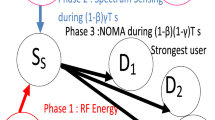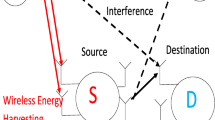Abstract
In this paper, we suggest to optimize both power allocation coefficients, harvesting and sensing durations for cognitive radio networks using non orthogonal multiple access (CR-NOMA). In the first slot, secondary transmitter harvests energy from radio frequency signal received from node A. In the second slot, secondary transmitter sense the channel to check if primary user is active or not. When primary user is idle, secondary transmitter transmits data to N NOMA users in the third slot. We derive and optimize the total throughput for Rayleigh channels.







Similar content being viewed by others
Availability of data and materials (data transparency)
Material and data are not available.
References
Li, Q. C., Niu, H., Papathanassiou, A. T., & Wu, G. (2014). 5G network capacity: Key elements and technologies. IEEE Vehicular Technology Magazine, 9(1), 71–78.
Saito, Y., Benjebbour, A., Kishiyama, Y., & Nakamura, T. (2013)System- level performance evaluation of downlink non-orthogonal multiple access (NOMA). In Proceedings of the IEEE International Symposium on Personal, Indoor Mobile Radio Communication (PIMRC), (pp. 611–615).
Ding, Z., Peng, M., & Poor, H. V. (2015). Cooperative non-orthogonal multiple access in 5G systems. IEEE Communications Letters, 19(8), 1462–1465.
Ding, Z., Dai, H., & Poor, H. V. (2016). Relay selection for cooperative NOMA. IEEE Communications Letters, 5(4), 416–419.
Men, J., & Ge, J. (2015). Non-orthogonal multiple access for multiple-antenna relaying networks. IEEE Communications Letters, 19(10), 1686–1689.
Niu, Y., Gao, C., Li, Y., Su, L., & Jin, D. (2016). Exploiting multi-hop relaying to overcome blockage in directional mmwave small cells. Journal of Communications and Networks, 18(3), 364–374.
Kim, J. B., & Lee, I. H. (2015). Non-orthogonal multiple access in coordinated direct and relay transmission. IEEE Communications Letters, 19(11), 2037–2040.
Zhong, C., & Zhang, Z. (2016). Non-orthogonal multiple access with co- operative full-duplex relaying. IEEE Communications Letters, 20(12), 2478–2481.
Liu, Y., Ding, Z., Elkashlan, M., & Poor, H. V. (2016). Cooperative non-orthogonal multiple access with simultaneous wireless information and power transfer. IEEE Journal on Selected Areas in Communications, 34, 4.
Varshney, L. (2008). Transporting information and energy simultaneously. In Proceedings of the IEEE international symposium on information theory (ISIT), Toronto, Canada, pp. 1612–1616.
Sun, H., Zhou, F., Hu, R. Q., & Hanzo, L. (2019). Robust beamforming design in a NOMA cognitive radio network relying on SWIPT. IEEE Journal on Selected Areas in Communications, 37(1), 142–155.
Liu, Y., Ding, Z., Elkashlan, M., & Yuan, J. (2016). Non-orthogonal multiple access in large-scale underlay cognitive radio networks. IEEE Transactions on Vehicular Technology, 65(12), 10152–10157.
Bhattacharjee, S., Acharya, T., & Bhattacharya, U. (2018). NOMA inspired multicasting in cognitive radio networks. IET Communications, 12(15), 1845–1853.
Zhou, F., Chu, Z., Sun, H., & Leung, V. C. M. (2018). Resource allocation for secure MISO-NOMA cognitive radios relying on SWIPT. IEEE International Conference on Communications (ICC), 2018, 1–6.
Liu, M., Song, T., & Gui, G. (2018). Deep cognitive perspective: Resource allocation for NOMA based heterogeneous IoT with imperfect SIC. IEEE Internet of Things Journal, 6(2), 2885–2894.
Xu, L., Zhou, Y., Wang, P., & Liu, W. (2018). Max-min resource allocation for video transmission in NOMA-based cognitive wireless networks. IEEE Transactions on Communications, 66(11), 5804–5813.
Hamad, Y., Emad, A., Arafat Al-Dweik, Blind receiver design for downlink cognitive-radio NOMA networks. In 2021 IEEE international conference on communications workshops (ICC workshops)
Shaima’, S., Abidrabbu, Hüseyin Arslan, Efficient power allocation for cognitive radio NOMA using game-theoretic based pricing strategy. In 2021 IEEE 93rd vehicular technology conference (VTC2021–Spring).
Myke, D.M., Valadao, Waldir S. S., Junior, Celso B. Carvalho, Trends and challenges for the spectrum efficiency in NOMA and MIMO based cognitive radio in 5G networks. In 2021 IEEE international conference on consumer electronics (ICCE).
Shaima’, S. A., Huseyin, A., Energy-efficient resource allocation for 5G cognitive radio NOMA using game theory. In 2021 IEEE wireless communications and networking conference (WCNC).
Aswathi, V., & Babu, A. V. (2021). Performance analysis of NOMA-based underlay cognitive radio networks with partial relay selection. IEEE Transactions on Vehicular Technology, 70(5), 4615–4630.
Mohammed, W. B., Mohammad, R. A., Network sum-rate maximization via joint relay selection and power allocation in energy-harvesting NOMA multicast cognitive radio networks. In 2020 international conference on communications, signal processing, and their applications (ICCSPA).
Ali, H. B. (2021). NOMA-based spectrum leasing in cognitive radio network: Power optimization and performance analysis. IEEE Transactions on Communications, 69, 7.
Satyanarayana Murthy N. (2021). A new HBS model in millimeter-wave beamspace MIMO-NOMA systems using alternative grey wolf with beetle swarm optimization. Wireless Personal Communications: Published online July.
Narasimha Nayak, V., & Gurrala, Kiran Kumar. (2021). Enhanced physical layer security for cooperative NOMA network with hybrid-decode-amplify-forward relaying via power allocation assisted control jamming. Wireless Personal Communications: Published online July.
Soumen, M., Sanjay, D. R., & Sumit, K. (2021). Partial relay selection in energy harvesting based NOMA network with imperfect CSI. Wireless Personal Communications: Published online May.
H, Lei, M, Xu., I Shafique, Ansari, G, Pan, Q, Khalid A., & Alouini, M. (2017). On secure underlay MIMO cognitive radio networks with energy harvesting and transmit antenna selection. IEEE Transactions on Green Communications and Networking, 1(2), 192–203.
Xi, Y., Burr, A., Wei, J. B., & Grace, D. (2011). A general upper bound to evaluate packet error rate over quasi-static fading channels. IEEE Transactions on Wireless Communications, 10(5), 1373–1377.
Proakis, J. (2007). Digital communications. Mac Graw-Hill, 5th edition.
Funding
This publication was supported by the Deanship of Scientific Research at Saudi Electronic University Saudi Arabia.
Author information
Authors and Affiliations
Contributions
RAED ALHAMAD is the author of the paper.
Corresponding author
Ethics declarations
Conflict of interest
The author states that there is no conflict of interest for this paper.
Additional information
Publisher's Note
Springer Nature remains neutral with regard to jurisdictional claims in published maps and institutional affiliations.
Rights and permissions
About this article
Cite this article
Alhamad, R. Optimal Harvesting and Sensing Duration for Cognitive Radio Networks Using Non Orthogonal Multiple Access. Wireless Pers Commun 122, 2183–2195 (2022). https://doi.org/10.1007/s11277-021-08987-y
Accepted:
Published:
Issue Date:
DOI: https://doi.org/10.1007/s11277-021-08987-y




